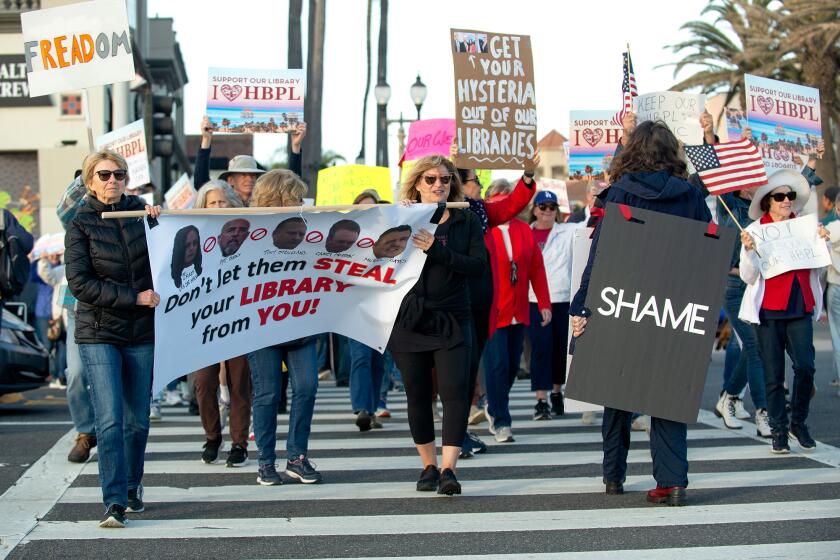NATURAL PERSPECTIVES:
- Share via
Last Thursday was the annual spring cleanup of the pickleweed-lined tideline at the Bolsa Chica Wetlands prior to nesting season of endangered Belding’s savannah sparrows.
The Bolsa Chica Conservancy organizes this water-based event in conjunction with the California Department of Fish and Game. Because pickleweed is easily crushed, the volunteers approach the trash from the water rather than by land.
Grace Adams, executive director of the conservancy, arranges for the loan of rental kayaks from REI in Huntington Beach and Malibu Kayak Rentals in Sunset Beach.
She also gathers experienced kayaking volunteers who ply the high water line with trash grabbers and plastic trash bags. Because boating generally is not allowed in the ecological reserve, all of the volunteers wear bright orange vests over their life preservers to let the public know that they are a cleanup crew, not recreational boaters.
Kayak cleanup day this year coincided with my field day with the new hires at the Orange County Conservation Corps where I work.
I asked Grace if my nine corps members could help, and she gave me an enthusiastic yes.
They were needed to help carry kayaks, paddles and life preservers to the launch site, launch the boats, carry bags of collected trash back to the Dumpsters, haul the kayaks back out of the water, wash them off and load them onto the vehicles that brought them.
Although there were a half-dozen experienced kayakers, there were not enough people to fill all of the seats in the double kayaks.
Grace said that corps members who knew how to swim could fill those empty seats. We chose Moses Amaro and Arturo Cruz.
Off they went along with the conservancy’s education coordinator, Diana Ortiz, for a morning of collecting trash in the Bolsa Chica.
The conservancy wanted some shore crabs to put into its marine aquarium, so the rest of us set up a crab trap to try our luck.
Corps member Richard Martinez showed a real knack for crabbing. In addition to the crab trap, which was baited with a chicken neck, Richard tried using a piece of chicken skin in a net.
The idea was to pull the net up quickly once a crab entered the net. But crabs are quicker and trickier than you might expect.
Richard was dismayed when a plucky crab made off with his bait, leaving the net empty.
We never did get any crabs, which has been my experience with crabbing.
Weeding kept the rest of us busy. Corps members Eric Lazorko, Edward Lopez, Constantine Regalado, Nydia Aguilar, Raul Urena and Alfonso Ortega pulled out wild radish, an invasive non-native plant. This improves habitat for native wildlife.
When that task was completed, we went across Warner to the public docks to collect mussels to feed to the sea stars in the conservancy’s aquarium.
In case you’re wondering what sea stars are, they’re the critters that we used to call starfish. Since starfish are invertebrates, not fish, their name has been changed to sea stars.
Back at the interpretive building, we also looked at the sponges that we gathered by the docks, using a dissecting microscope.
The corps members experimented with squeezing water out of the sponges and seeing them take up water again.
The breadcrumb sponges that live in Huntington Harbour and Bolsa Chica are more fragile than the species of sponges that are used to wash cars, but they have the same porous structure as car-washing sponges.
The ochre stars in the conservancy’s marine aquarium seemed very grateful for the food that we brought back. Or maybe gratitude is an emotion that is beyond them.
Let’s just say that they were eager eaters. They glommed onto the mussels in an instant.
Corps members got to watch the ochre stars open the mussels, although the eating process was hidden from our view.
The sea star uses its powerful arms to pry the mussel apart, hunching over the shellfish. Then it extrudes its stomach into the shell to digest the meaty contents.
The giant sea anemone was trying to eat one of the plastic plants in the aquarium, so I had the corps members smash a mussel, pick out the meat and feed it to the anemone. The anemone instantly closed around the mussel.
We also fed opened mussels to the conservancy’s two-spotted octopus. It quickly snaked a tentacle out from under the rock where it was hiding, scarfing up one mussel after another.
The last mussel drifted a bit out of its reach, so the octopus came out of hiding, both eyes standing upright on stalks. It grabbed that last mussel and stuffed it into its mouth, which is under the head, in the center of its eight arms. What a sight!
After lunch, two expert kayakers stayed to act as instructors for the rest of the corps members.
I divided my crew into two groups. Eric, Arturo, Moses and Raul paddled one set of kayaks back to Sunset Beach in the company of a volunteer instructor, Greg Griffin. After returning the kayaks, they walked back to the conservancy.
The other corps members took the rental kayaks from REI and paddled over to Huntington Harbour with Larry Rolewic as instructor, and Javier Cabrera, the orientation supervisor, accompanying them.
After they learned to handle their crafts, the corps members gathered more mussels from the docks. The highlight was a pod of dolphins that came into the harbor to feed. One dolphin breached right beside the kayaks, an awesome sight.
What a great learning opportunity this amazing day was for all of us.
VIC LEIPZIG and LOU MURRAY are Huntington Beach residents and environmentalists. They can be reached at [email protected].
All the latest on Orange County from Orange County.
Get our free TimesOC newsletter.
You may occasionally receive promotional content from the Daily Pilot.



